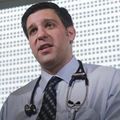Keynote Presentation: What the NIH Serosurvey Tells Us So Far and Why We Should Try to Develop a Broadly Protective/Universal Beta-Coronavirus Vaccine
Asymptomatic SARS-CoV-2 infection and delayed implementation of diagnostics have led to poorly defined viral prevalence rates. To address this, we analyzed seropositivity in US adults who have not previously been diagnosed with COVID-19. Individuals with characteristics that reflect the US population were selected by quota sampling from volunteers. Enrolled participants provided medical, geographic, demographic, socioeconomic information, and dried blood samples. The majority (88.7%) of samples were collected between May 10th and July 31st, 2020. The highest undiagnosed seropositivity was detected in Black/African American participants, younger, female, Hispanic, and Urban residents, and lower undiagnosed seropositivity in those with chronic diseases. These data indicate that there were 4.8 undiagnosed cases for every diagnosed case of COVID-19, and an estimated 16.8 million undiagnosed cases by mid-July 2020. Given the high point estimate of undiagnosed seropositivity in younger donors, lower point estimates in individuals with pre-existing conditions such as diabetes, and the vaccine rollout starting with older persons and those at risk, long-term study of naturally acquired immunity, vaccine acquired immunity, and vaccine boosted naturally acquired immunity will be necessary to fully understand the correlates of protection, durability of SARS-CoV-2 immunity, and the impact immunity will have long-term on the spread of SARS-CoV-2 and other future variants or novel coronaviruses. It is also clear from these data that novel coronaviruses can spread rapidly throughout human populations despite public health measures and we must therefore prepare for future novel coronaviruses and begin investigation into broadly protective countermeasures such as vaccines to mitigate this risk.
Learning Objectives:
1. Understand the spread of SARS-CoV-2 in the first 6 months of the pandemic, the limitations of testing, and how this impacts the overall epidemiologic data being used to direct public health measures
2. Understand what we can learn from these data and how we can alter our future pandemic responses to reduce the negative consequences of a pandemic
3. Understand the need for broadly protective vaccines/countermeasures, how we failed in the past, what research needs to be done, how novel vaccines they could be evaluated, and what real expectations are for them


